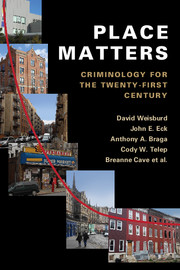Book contents
- Frontmatter
- Contents
- List of figures
- List of tables
- List of contributors
- Preface
- 1 Crime Places within Criminological Thought
- 2 The Concentration of Crime at Place
- 3 Theories of Crime and Place
- 4 The Importance of Place in Mainstream Criminology and Related Fields: Influences and Lessons to be Learned
- 5 Methods of Place-Based Research
- 6 Reducing Crime at High-Crime Places: Practice and Evidence
- 7 Crime Places in the Criminological Imagination
- Notes
- References
- Index
7 - Crime Places in the Criminological Imagination
Published online by Cambridge University Press: 05 April 2016
- Frontmatter
- Contents
- List of figures
- List of tables
- List of contributors
- Preface
- 1 Crime Places within Criminological Thought
- 2 The Concentration of Crime at Place
- 3 Theories of Crime and Place
- 4 The Importance of Place in Mainstream Criminology and Related Fields: Influences and Lessons to be Learned
- 5 Methods of Place-Based Research
- 6 Reducing Crime at High-Crime Places: Practice and Evidence
- 7 Crime Places in the Criminological Imagination
- Notes
- References
- Index
Summary
We began this book by noting that criminologists have largely ignored the involvement of microgeographic places in crime. Mainstream criminologists have focused on “who done it?” and not “where done it?” (Sherman 1995). At least for the last century the key inquiries of crime and the key prevention approaches have looked to doing something about criminal motivation (Sutherland 1947; Reiss 1981). Why people commit crime has been the main focus of criminology (Brantingham and Brantingham 1990; Weisburd 2002), and catching and processing offenders has been the main focus of crime prevention (Weisburd 2008). In contrast, the criminology of place (Sherman et al. 1989; Weisburd et al. 2012), which began to develop in the 1980s and 1990s (Brantingham and Brantingham 1981; 1984; Eck 1994; Eck and Weisburd 1995; Roncek and Bell 1981; Weisburd and Green 1995a), provides an alternative vision of how we can understand crime and the crime problem. Like the emergence of community criminology during the same period (Bursik 1988; Morenoff et al. 2001; Sampson 2008; Sampson et al. 1997) the criminology of place has offered a new set of mechanisms for crime study and a new set of methods for doing something about the crime problem.
Theory has been a driving force in criminological study, and as we note below, we think that more not less attention to theory is important for advancing the criminology of place. However, theories are about something and try to explain something. When we change the unit of analysis, we are changing the target for theory. The criminology of place proposes a new target. It focuses on places, rather than people. Its goal is to explain the criminal involvement of microgeographic units rather than trying to explain the criminal involvement of people. This does not mean we ignore the role of individuals in the crime problem. But it does mean that we begin our inquiries with the place and see the individuals as only one part of the crime equation at places.
We have illustrated in the preceding chapters the extent to which theory, method, and empirical evidence about crime places have been developing over the last three decades. In this concluding chapter, we want to draw from our review of what is known some key themes that we think our work has identified, and key questions that still need to be answered.
- Type
- Chapter
- Information
- Place MattersCriminology for the Twenty-First Century, pp. 140 - 158Publisher: Cambridge University PressPrint publication year: 2016



